Camucia, (train) station of Camucia: to go to hell take a change.
But
you don't have to go far:
hell is just there a few steps away, in
a
dilapidated railway shed:
windows with broken glass, scraped walls, the atmosphere of a shabby
western movie.
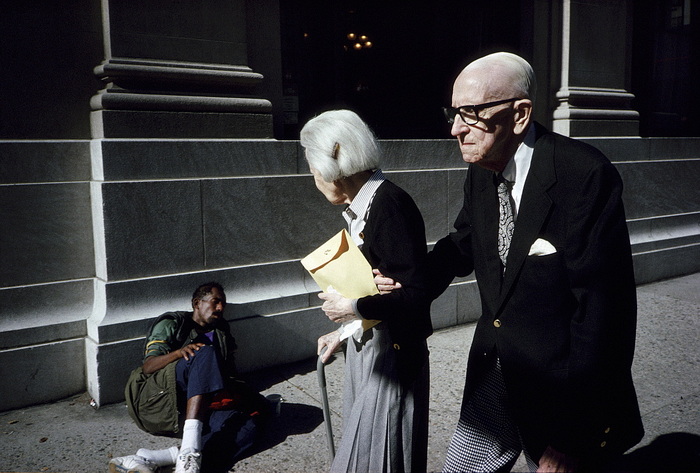
This hell cannot hurt you, except in the depth of your heart: it’s
just photos! But who had ever seen such things in photographic
images? Houses filled with dirtiness, drunken people on one’s back,
blood on sidewalks, creepy alleys, people with guns. This is the
America of the blacks, of the outcasts, of the extreme and fierce
poverty, of the drug-addicts. This is the America of racism and the
violence which it is based on, in such a deep way that, in order to
perceive it half a century ago, a man had to enter into it, body and
soul, and risk his life in the process.
But in that hell, there is also warmth, not that of flames but that
of human feelings: in couples embracing each other, in mothers
cuddling children, there is love.” If you choose to be a vagabond,
that is what you meet, all mixed up”.
The author of those photos is there, in image and in person, and you
may recognize him even after fifty years: same mass of hair, same
long beard tied into a small braid, only both of them now white.
Jacob Holdt is a 75-year-old smiling hippie, so much in peace with
the world that it’s hard to believe he went through the adventure
documented in this exposition
curated
by Lars Lindemann and Paolo Woods for the festival “Cortona on the
Move”, which you still have time to visit. It is a striking summary
of images, even a little amended of the most shocking ones.
The author is looking for an Italian publishing house, and we hope
he will find it, because his story is much more than an odd novel
mixing up Kerouak with Tocqueville. For the time being he concocted
a virtual book, available online in many different languages. It’s
a real Odyssey, indeed, bearing the same proceeding: sea storms,
witches, Cyclops.
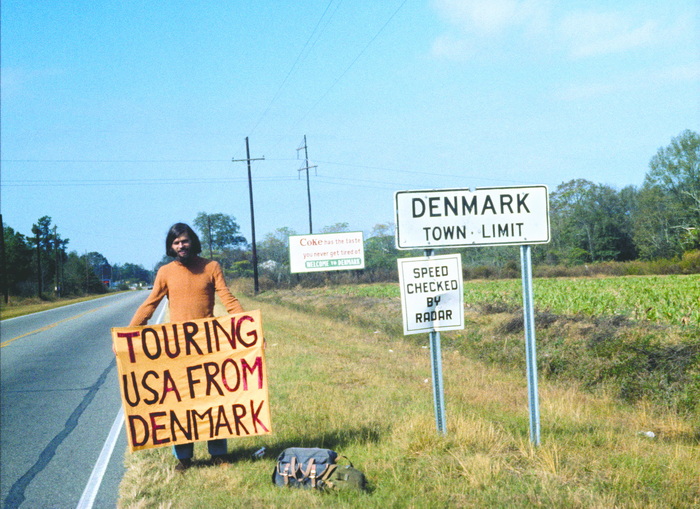
Robberies,
beatings
and arrests
To begin
with: a Dane, son of a protestant minister, rebellious, in the early
70s, at the age of 23 Jacob leaves from Canada with 40 dollars in
his pocket and a vague idea of traveling down to South America to
join some revolutionary movement, no matter what. Robbed at once, he
stops in the US, and survives as he can. As a vagabond. Finding
hospitality with whoever, he stumbles on. Mainly by outcasts. That
means, obviously, by blacks. For 5 years he hitchhikes 118.000
miles, sleeping in more than 400 homes in 48 States, hosted by
single mothers, by gangsters, prostitutes, gays, drug dealers, but
also by
white upper class
(yes,
sometimes your thumb may stop even a limousine, if you are shrewd
enough to hide your hair under a presentable wig) and even by
families in the Ku Klux Klan.
As a white caught in the middle of those two worlds, he collects a
stunning number of misadventures, robberies,
beatings,
arrests,
shootings,
knifings:
(by
whites and by blacks), death threats. He helps a native-American
uprising in Wounded Knee, survives a firebombing provoked by whites
to punish him for living with Mary, a black girl.
He has a camera, sent to him by his parents, as a way to tell him:
allow us to see. Lacking in knowledge of photography, he takes
pictures the way a tourist would do, devoid of any aesthetic quality
(or maybe not…), snaps them at times faded and blurred, by the
thousand.
Document, screen, diary.
”I
merely took pictures of people I was living with”.
To pay for his films, twice a week he sells his plasma to blood
banks: 5 dollars per session. He later publishes a book, American
Pictures, in Danish language, in black and white and on cheap
paper, but it turns out to be a bestseller, gets translated and the
author begins to be called out to give lectures.
In short: during several more decades of traveling
in the US, his life is that of a lecturer: more than
7.000 talks, 35.000 hours of slide shows.
Recurrences of history: also of Danish descent was Jacob Riis, the
reform-minded sociologist who a century ago also lectured and with
blows of flash
in
immigrant ghettos in New York
made his
book How the Other Half Lives
(the title of his book, Simon & Schuster publisher).
“I like better to see myself as a teacher than a photographer” tells
me Holdt. “I understood I had to do something for the education of
white Americans, to help them beyond the trauma of being racist, get
them to understand that all of us are victims of racism”.
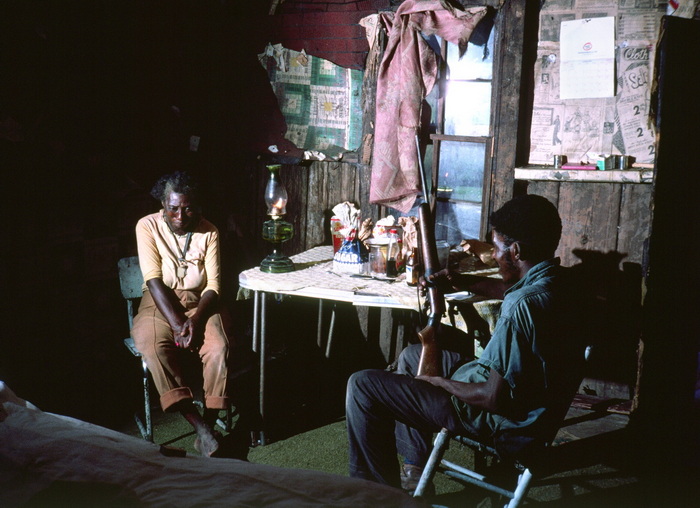
The multimillionaire in the shack
All of
us victims. Perhaps someone will not agree.
But
Jacob also prefers to use it lightly, the word racism;
he prefers to say, “the system of our daily oppressive thinking”.
Yes, racism, he is sure of that, is a social disease. ”It infects
everyone, myself included, obviously. I noticed,
after
teaching for long in white universities, that my thinking was
veering toward prejudice.
To counter it,
I would go back to see my friends in the ghettos."
Bringing along a few terrorized students as well. And
even a billionaire, Anna Roddick,
owner of
The Body Shop cosmetics empire.
“She wanted to invest in social programs, so I brought her to sleep
in the shacks” he says smiling “My wish was to make her understand
how we constantly develop hostile images of our fellow human beings,
image that we then use to justify our violence. I wanted to explain
something I had come to understand, that the oppressor and the
oppressed constantly create each other, that none of us is free”.
During the 70’ the great movements for civil rights were in
decrease. The racial question was disappearing from the political
agenda, regarded as resolved by equality laws,” all on paper,
though. For white liberals it was enough to assert that
the laws were there.
In the
process it was more and more difficult for blacks to denounce the
wrongs suffered.
Bombarded by television fantasies about how free
they now
were, they had difficulties identifying their oppressor, and
therefore
looked
to themselves for the cause of their growing pain."
But today is different: there is the Black Lives Matter, no?
He smiles enigmatically,” Sure,
I never saw so many young whites marching together with blacks. Who
isn’t filled with indignation when they see police killing blacks?
But police violence is just the froth of the problem.
Underneath there is still an abyss of injustice that no one
perceives.
When I first went to America, the difference in
wealth between an average black or white person was 1 to 6.
Today is 1 to 20.
From
shacks, poor blacks have moved into house trailer, but their lives
have not improved.
Only their anger got deeper inside their souls”.
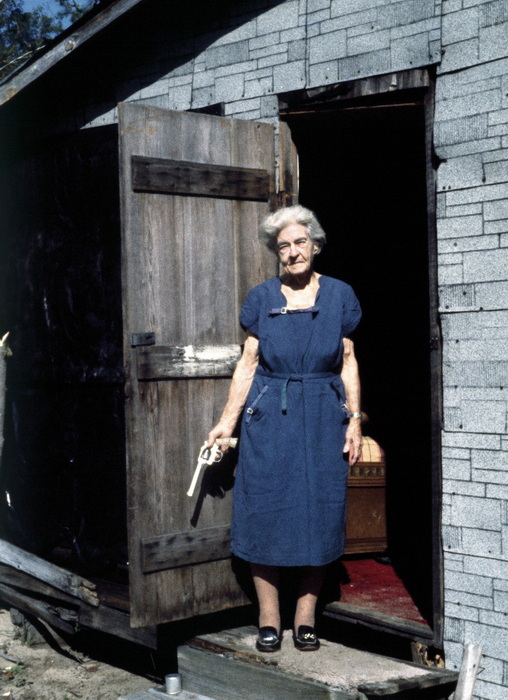
Against fear
Jacob,
but….if we are all victims, where are the offenders?
He thinks over it a bit. ”The first time I saw a gun aimed at me I
got scared.
Whether
a white man or a black man holds it,
believe me, it makes no difference. To counter the fear, I started
to think: what brings a person to aim a gun at my face? I later
named it my
“technique of preventive forgiveness …”
Yes, but
your answer? “We all fear something. Our weakness, our negative
self-esteem as human beings. Such being the case, we search for
scapegoats in others."
Would you say so even about a guy active in the KKK?
“
I would say so.
Most
Klan members have never killed anyone,
nor practiced any violence. The Klan is a shelter for self-
affirmation,
which is self-defence, even self-hate.
I even
took one of them, Jeff, into many black homes.
Here is his picture, of him embracing Virginia”.
I understand they called you Christ, not just because
of your physical appearance....
“I
would rather be the Samaritan woman at the well, offering water to
everyone.
But I
realize that I also exploit people with my pictures, from which they
will not benefit."
From Nelson Mandela, Holdt borrowed a word, ubuntu, meaning:
“The feeling of being human only through other people’s humanity”.
What could be the final goal then? A reconciliation between whites
and blacks? The dream of Martin Luther King? Is it realistic?
"I don't cultivate utopias. I say, take
responsibility for your racism, acknowledge your racism but act as
an anti-racist. Try to become a consciously anti-racist racist."
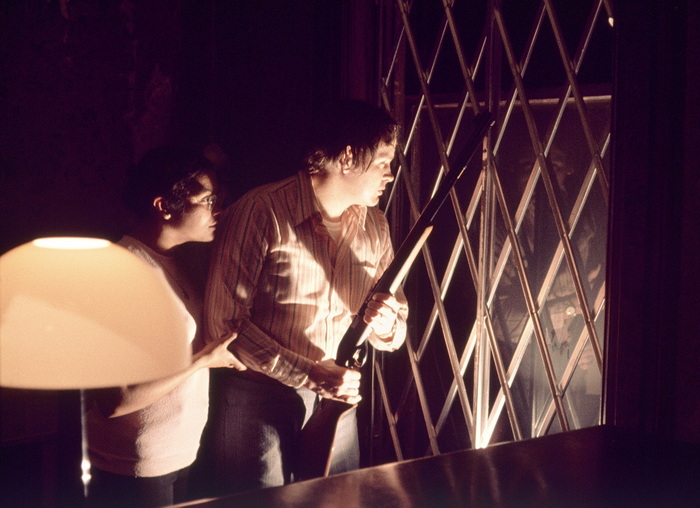
________________________________________________________________________________________
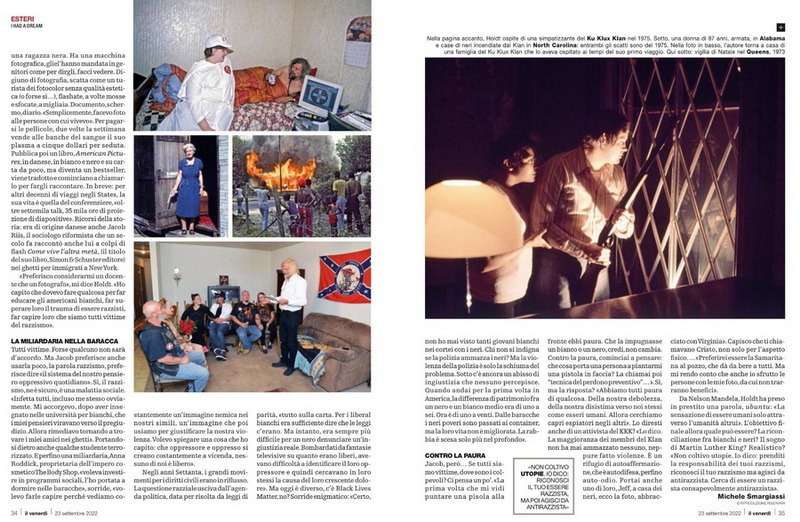
Italian original:
UN HIPPIE A
CASA DEL KKK
ANNI 70, JACOB HOLDT GIRA GLI USA FREQUENTANDO I PIÙ POVERI TRA I
NERI E I PIÙ SUPREMATISTI TRA I BIANCHI. CON LE FOTO DI QUEL VIAGGIO
OGGI INSEGNA CIÒ CHE HA IMPARATO: "IL RAZZISMO? UNA MALATTIA”
di Michele Smargiassi
CAMUCIA, stazione di Camucia, per l'inferno si cambia. Ma non c'è da
fare tanta strada: l'inferno è lì a due passi, in un cadente
capannone ferroviario, finestre coi vetri rotti e musi scrostati,
un'aria da Far West scalcinato. Questo inferno non vi farà male se
non al cuore: sono fotografìe. Ma chi ha mai visto questo coso in
fotografia? Case piene di sporcizia, ubriachi riversi, sangue sui
marciapiedi, vicoli da brivido, uomini armati. È l'America dei neri,
degli emarginati, della povertà estrema e feroce, dei
tossicodipendenli, l'America del razzismo e della violenza che sta
sotto, ma così sotto che per vederla, mezzo secolo fa, un uomo ha
dovuto entrarci con anima e corpo, e rischiarci la vita.
C'è
anche calore in quell'inferno:
non di fiamme, ma di umanità, coppie
che si abbracciano, madri che coccolano
bambini, c'è amore. “Se scegli di
essere un vagabondo, quel che incontri
è
tutto questo, mescolato assiemo”.
L'autore di queste fotografie è li, sia
nelle foto che in carne ed ossa, e lo riconosci
anche se sono passati cinquant'anni:
la stessa barba
lunga raccolta in una
treccina,
semplicemente ora entrambe
candide. Jacob Holdt
è un sorridente hippie di settantacinopie anni, così
in
pace col mondo che sembra difficile
abbia vissuto l'avventura documentata in
questamostra curata da Lars Lindemann
e Paolo Woods al festival "Cortona
on the Move" che fate ancora in
tempo a vedere.
Sta cercando un editore
italiano, e speriamo lo trovi, perché
la sua storia è molto più di un romanzo
curioso che mescola Kerouac e Tocqueville.
Éun 'Odissea, dawero, con lo stesso
andamento: mari tempestosi, streghe
e ciclopi.
RAPINE, BOTTE E ARRESTI
Per cominciare: danese, figlio di un pastore
protestante, ribelle, nei primi Settanta,
a 23 ani, parte per il Canada con
quaranta dollari in tasca e la vaga idea
di scendere fino in Sudamerica per
unirsi a qualche movimento rivoluzionario.
Rapinato subito, si ferma negli
Usa e vive come può. Da vagabondo.
Facendosi ospitare da chi capita. Soprattutto
dagli emarginati. Cioè dai
neri, ovviamente. In cinque anni viaggia
in autostop per 118 mila miglia dormendo
in più di 400 case di 48 Stati,
ospitato da ragazze madri, gangster,
prostitute, gay, spacciatori, ma
anche da straricchi bianchi (si, ogni tanto il
pollice ferma anche una
limousine, se hai
l'accortezza di nascondere i capelli sotto una parrucca
presentabile) e perfino
da famiglie del Ku Klux Klan.
Da bianco in mezzo ai due
mondi, collezio n a un numero impressionante di disavventure, rapine, botte, arresti, sparatorio, coltellati: (da bianchi e da neri),
minacce di morte, aiuta una rivolta
indiana a Wounded Knee, scampa a un
incendio doloso appiccato dai bianchi
per punirlo di vivere con Mary,
una ragazza nera.
Ha una macchina fotografica, gliel'hanno mandata in
genitori come per dirgli, facci vedere. Digiuno di fotografia,
scatta come un turista dei fotocolor senza qualità estetica (o forse
sì...), flashate, a volte mosse esfocate, a migliaia. Documento,
schermo, diario.
«Semplicemente,facevo foto alle persone con cui
vivevo».
Per pagarsi le pellicole, due volto la settimana vende alle banche
del sangue il suo plasma a cinque dollari per seduta. Pubblica poi
un libro, American Pictures, in danese, in bianco e nero e su carta
da poco, ma diventa un bestseller, viene tradotto e cominciano a
chiamarlo per fargli raccontare.
In breve: per altri decenni di viaggi negli States, la sua vita è
quella del conferenziere, «oltre settemila talk, 35 mila ore di
proiezione di diapositive». Ricorsi della storia: era di origine
danese anche Jacob Riis, il sociologo riformista che un secolo fa
raccontò anche lui a colpi di flash Come vive l'altra metà,
(il titolo del suo libro, Simon & Schuster editore) nei ghetti per
immigrati a New York.
«Preferisco considerarmi un docente che un
fotografo», mi dice Holdt. «Ho capito che dovevo fare qualcosa per
far educare gli americani bianchi, far superare loro il trauma di
essere razzisti, far capire loro che siamo tutti vittime del
razzismo».
LA MILIARDARIA
NELLA BARACCA
Tutti vittime. Forse qualcuno non sarà d'accordo. Ma
Jacob preferisce anche usarla poco, la parola razzismo, preferisce
dire «il sistema del nostro pensiero oppressivo quotidiano».
Sì, il razzismo, ne é sicuro, o una malattia sociale. «Infetta
tutti, incluso me stesso ovviamente. Mi accorgevo, dopo aver
insegnato nelle università per bianchi, che i miei pensieri viravano
verso il pregiudizio. Allora rimediavo tornando a trovare i miei
amici nei ghetti».
Portandosi dietro anche qualche studente terròrizzato. E perfino una
miliardaria, Anna Roddick, proprietaria dell'impero cosmetico The
Body Shop, «voleva investire in programmi sociali, l'ho portata a
dormire nelle baracche», sorride, «volevo farle capire perché
vediamo costantemente un'immagine nemica nei nostri simili,
un'immagine che poi usiamo per giustificare la nostra violenza.
Volevo spiegare una cosa che ho capito: che oppressore e oppresso si
creano costantemente a vicenda, nessuno di noi o libero».
Negli anni Settanta, i grandi movimenti peri diritti
civili erano in riflusso. La questione razziale usciva dall'agenda
politica, data per risolta da leggi di parità, «tutto sulla carta.
Per i liberai bianchi era sufficiente dire che le leggi c'erano. Ma
intanto, era sempre più difficile per un nero denunciare
un'ingiustizia reale. Bombardati dafantasie televisive su quanto
erano liberi, avevano difficoltà a identificare il loro oppressore e
quindi cercavano in loro stessi la causa del loro crescente dolore».
Ma oggi è diverso, c'è Black Lives Matter, no? Sorride enigmatico:
«Certo, non ho mai visto tanti giovani bianchi nei cortei con i
neri. Chi non si indigna se la polizia ammazza i neri? Ma la
violenza della polizia è solo la schiuma del problema. Sotto c'è
ancora un abisso di ingiustizia che nessuno percepisce. Quando andai
por la prima volta in America, la differenza di patrimonio fra un
nero o un bianco medio era di uno a sei. Ora è di uno a venti. Dalle
baracche i neri poveri sono passati ai container, ma la loro vita
non è migliorata. La rabbia è scesa solo più nel profondo».
CONTRO LA PAURA
Jacob, pero... Se tutti siamo vittime, dove sono i
colpevoli?
Ci pensa un po'. «La prima volta che mi vidi puntare una pistola
allafronte ebbi paura. Che la impugnasse un bianco o un nero, credi,
non cambia. Contro la paura, cominciai a pensare: che cosa porta una
personaa piantarmi una pistola in faccia? La chiamai poi "tecnica
del perdonopreventivo"...».
Sì, ma la risposta? «Abbiamo tutti paura di qualcosa. Della nostra
debolezza, della nostra disistima verso noi stessi come esseri
umani. Allora cerchiamo capri espiatori negli altri».
Lo diresti anche di un attivista del KKK?
«Lo dico. La maggioranza dei membri del Klan non ha mai ammazzato
nessuno, neppure fatto violenze. È un rifugio di autoafformazione,
che è autodifesa, perfino auto-odio. Portai anche uno di loro, Jeff,
a casa dei neri, ecco la foto, abbracciato con Virginia.»
Capisco che ti chiamavano Cristo, non solo per l'aspetto fisico....
«Preferirei essere la Samaritana al pozzo, che da da bere a tutti.
Ma mi rendo conto che anche io sfrutto le persone con le mie foto,
da cui non trarranno benefici».
Da Nelson Mandela, Holdt ha preso in prestito una
parola, ubuntu: «La sensazione di essere umani solo attraverso
l'umanità altrui».
L'obiettivo finale allora quale può essere? La riconciliazione fra
bianchi e neri? Il sogno di Martin Luther King? Realistico?
«Non coltivo utopie. Io dico: prenditi la responsabilità dei tuoi
razzismi, riconosci il tuo razzismo ma agisci da antirazzista. Cerca
di essere un razzista consapevolmente antirazzista».
Michele Smargiassi
23 settembre 2022 - il venerdì